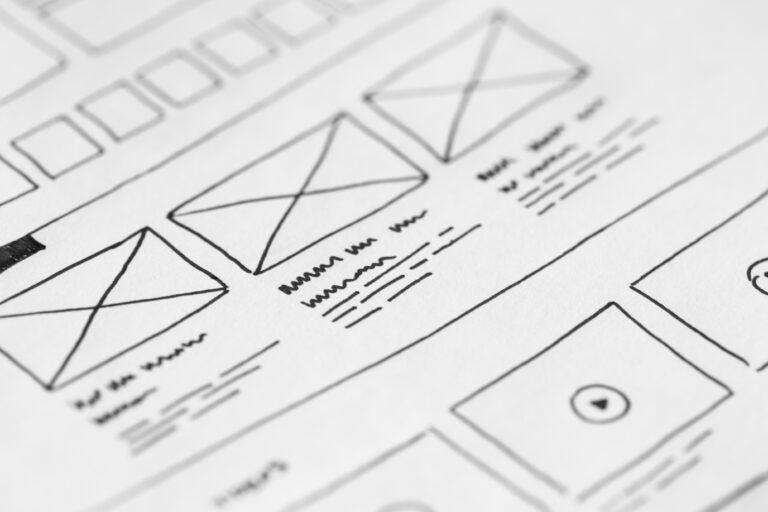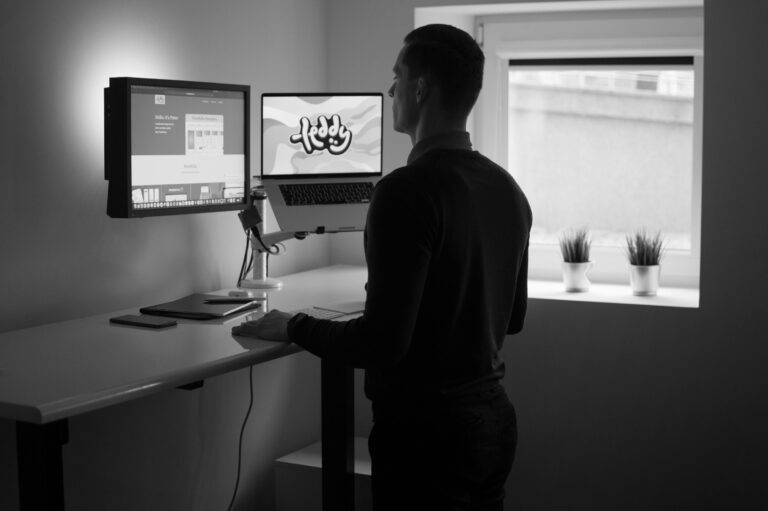In an increasingly digital world, UX design plays a vital role in creating seamless and enjoyable interactions between users and digital products or services. As technology continues to advance, artificial intelligence (AI) is becoming an integral part of our lives. This raises the question: How can UX design harness AI to enhance user experiences?
If you’re an employer looking to recruit, please see our product design and UX recruitment services page for more information about how we work.
What is UX Design?
UX design, short for user experience design, is the process of designing digital products or services with a focus on enhancing user satisfaction and overall usability. It involves understanding users’ needs, behaviours, and motivations to create intuitive and meaningful experiences. UX Designers employ various techniques such as user research, information architecture, interaction design, and visual design to craft compelling user experiences.
What is AI?
AI, or artificial intelligence, refers to the simulation of human intelligence in machines that can perform tasks that would typically require human intelligence. AI systems are capable of learning from data, recognising patterns, making predictions, and adapting their behavior based on the information they process. Machine learning (ML) and deep learning (DL) are subsets of AI that enable computers to learn and improve without explicit programming.
How UX Design Can Harness AI?
AI can be a powerful tool in the hands of UX Designers, enabling them to create more personalised and seamless user experiences.
Here are eight examples of how AI can be harnessed in UX design:
Personalised recommendations
AI algorithms can analyse user preferences and behaviour to provide personalised recommendations for products, content, or services. By understanding users’ interests, AI can enhance the user journey and increase engagement.
Natural language processing (NLP)
NLP allows machines to understand and interpret human language. UX Designers can leverage NLP to create conversational interfaces, chatbots, and voice assistants that provide more intuitive and human-like interactions.
Sentiment analysis
AI-powered sentiment analysis can analyse user feedback, reviews, and social media posts to gauge user sentiment and identify areas for improvement. This data can inform UX design decisions and help optimise user experiences.
Predictive analytics
AI algorithms can analyse user data and behaviour patterns to make predictions about future user actions or needs. UX Designers can leverage predictive analytics to anticipate user needs, tailor experiences, and provide proactive assistance.
Automated testing
AI-based testing tools can automate the process of testing user interfaces, identifying usability issues, and generating reports. This speeds up the testing phase and helps UX Designers identify and fix issues more efficiently.
Image and video recognition
AI-powered image and video recognition can enable UX Designers to create interfaces that can understand and interpret visual content. This opens up possibilities for augmented reality (AR), virtual reality (VR), and immersive user experiences.
User behaviour analysis
AI algorithms can analyse user behaviour data to uncover patterns and insights that inform UX design decisions. By understanding how users interact with a product or service, designers can optimise the user journey and improve conversion rates.
Intelligent automation
AI can automate repetitive tasks and streamline workflows, allowing UX Designers to focus on more strategic and creative aspects of their work. This includes automating tasks like content management, data analysis, and prototyping.
AI tools for the UX industry
Several AI tools have emerged to support UX Designers in their work. These tools leverage AI and ML techniques to automate tasks, provide insights, and enhance the design process. Some notable AI tools for the UX industry include:
a) Framer X: Framer X combines design and code to create interactive and responsive prototypes. It uses AI to automate repetitive tasks and streamline the design process.
b) Adobe Sensei: Adobe Sensei is an AI framework that powers various Adobe products, including Photoshop and Illustrator. It provides features like content-aware fill and image recognition, enabling designers to work more efficiently.
c) UXCam: UXCam is an AI-powered user session recording and analysis tool. It helps UX designers understand how users interact with their products by recording and analysing user sessions, providing valuable insights for design improvements.
d) Sketch2React: Sketch2React is an AI tool that converts Sketch designs into interactive React components. It automates the process of turning static designs into functional prototypes, saving time and effort for designers.
e) ContentSquare: ContentSquare is an AI-driven UX analytics platform that provides insights into user behaviour and engagement. It helps UX designers optimise user experiences by understanding how users interact with their interfaces.
f) Morph.ai: Morph.ai is an AI chatbot platform that allows UX designers to create conversational interfaces without coding. It enables designers to build chatbots for various platforms and integrate them seamlessly into their products or services.
g) UXPin: UXPin is a collaborative design and prototyping tool that leverages AI to automate design tasks and improve design consistency. It offers features like design systems, interactive states, and design versioning.
h) Canva: Canva is a popular graphic design platform that uses AI to simplify the design process. It provides templates, design suggestions, and automated resizing, making it accessible to users with limited design skills.
Will UX be Replaced by AI?
The question of whether AI will replace UX entirely is a topic of debate. Here are six arguments for and against the replacement of UX by AI:
Yes:
- Automation: AI can automate certain aspects of the design process, reducing the need for manual intervention and potentially replacing some tasks traditionally performed by UX Designers.
- Data-driven design: AI can analyse large datasets and generate design recommendations based on user behaviour and preferences, potentially making UX Designers less involved in the decision-making process.
- Generative design: AI algorithms can generate design variations and solutions based on predefined criteria, potentially replacing some ideation and iteration tasks performed by UX Designers.
- Template-based design: AI-powered design tools can provide pre-designed templates and layouts, enabling non-designers to create visually appealing interfaces without the need for extensive design expertise.
- Natural language generation: AI can generate content and copy based on user inputs, potentially reducing the need for UX writers or content creators in certain scenarios.
- Personalisation: AI algorithms can create personalised experiences based on user data, potentially reducing the need for manual customisation.
No:
- Human-centred design: UX design is rooted in understanding human behaviour, needs, and emotions. AI may enhance the design process, but human empathy and creativity are essential for creating truly meaningful user experiences.
- Ethical considerations: AI algorithms are not inherently unbiased or ethical. UX Designers play a crucial role in ensuring that AI systems are designed and implemented responsibly, considering the potential social and ethical implications.
- Strategic thinking: UX Designers bring strategic thinking and a holistic perspective to the design process. They consider business goals, user needs, and market trends to create cohesive and impactful experiences that align with the overall product vision.
- Collaboration and communication: UX Designers often collaborate with cross-functional teams and stakeholders to align on design decisions. Effective communication and collaboration skills are essential, and AI cannot fully replace human interaction in this context.
- Intuition and creativity: UX Designers leverage intuition and creativity to solve complex problems and explore innovative solutions. AI, while capable of pattern recognition, lacks the human capacity for intuition and creativity.
- Emotional design: UX Designers understand the importance of emotional design and the impact it has on user experiences. They can leverage design principles and psychology to create emotionally engaging interfaces, which may be challenging for AI systems to replicate.
In conclusion, while AI has the potential to augment and enhance UX processes, it is unlikely to fully replace UX roles completely. The human-centred approach, strategic thinking, creativity, and ethical considerations brought by UX designers are irreplaceable in creating meaningful and impactful user experiences.
Midjourney and Galileo AI case study
Problem: Midjourney, a travel booking platform, faced the challenge of providing personalised and seamless user experiences to its customers. They wanted to enhance their recommendation system and improve the overall user journey.
Solution: Midjourney partnered with Galileo AI, an AI-powered recommendation engine. Galileo AI implemented advanced machine learning algorithms to analyse user preferences, travel history, and contextual data to provide personalised recommendations for flights, accommodations, and activities.
Challenges: The main challenges faced during the implementation of AI in Midjourney’s UX design included:
a) Data integration: Integrating multiple data sources and ensuring data quality were complex tasks that required collaboration between Midjourney and Galileo AI.
b) Algorithm accuracy: Achieving high accuracy in the recommendation engine required iterative improvements and fine-tuning of the machine learning algorithms. Continuous testing and validation were crucial to ensure reliable results.
c) User acceptance: Introducing AI-powered recommendations to users required effective communication and user education to build trust and overcome any concerns about data privacy and personalisation.
Outcome: The collaboration between Midjourney and Galileo AI resulted in significant improvements in the user experience. Personalised recommendations led to higher conversion rates and increased customer satisfaction. Users appreciated the tailored suggestions and found the platform more user-friendly and engaging. The AI-powered recommendation engine enabled Midjourney to differentiate itself in the competitive travel industry and gain a competitive edge.
The future of UX design
The future of UX design holds tremendous potential with the continued integration of AI. Here are eight future trends to look out for:
Hyper-personalisation
AI algorithms will enable even more precise personalisation, delivering highly tailored experiences based on individual preferences, context, and behaviour.
Voice-first interfaces
Voice assistants and natural language processing will play a more significant role in user interfaces, allowing users to interact with digital products using voice commands.
Augmented Reality (AR) and Virtual Reality (VR)
AR and VR technologies will create immersive and interactive user experiences, transforming how users engage with digital products and services.
Emotional intelligence
AI algorithms will become more adept at recognising and responding to user emotions, enabling interfaces to adapt and provide empathetic interactions.
Ethical AI
As AI becomes more prevalent, there will be an increased focus on designing ethical AI systems that prioritise fairness, transparency, and accountability.
Continuous user monitoring
AI-powered analytics will provide real-time insights into user behaviour, allowing UX Designers to make data-driven design decisions and iterate quickly.
Generative design systems
AI will automate the design process further, generating design variations and solutions based on user requirements, constraints, and objectives.
UX Design assistants
AI-powered design assistants will support UX Designers by automating routine tasks, providing design recommendations, and offering insights based on user data and industry best practices.
Conclusion
The future of UX design in an AI-driven world is promising. AI has the potential to enhance and augment the UX process, enabling designers to create more personalised, seamless, and engaging user experiences. However, it is important to recognise that AI is a tool that complements the skills and expertise of UX Designers rather than replacing them entirely.
As the field of UX design evolves, it is crucial for designers to embrace AI technologies, leverage its capabilities, and maintain a human-centred approach to create experiences that truly resonate with users in this AI future.
Need help with Product Design and UX recruitment? Reach out to us today.




